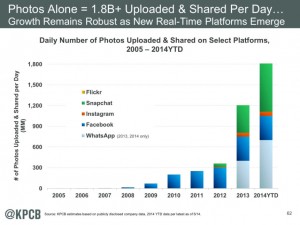Mary Meeker, Kleiner Perkins investor, just released her 2014 her annual Internet trends report which briefly trended on Twitter yesterday. Year after year, the report is slowly becoming a yearly milestone for the those in the internet business and those just curious about it. For us, it’s another opportunity to look at fresh numbers. And this year, like every other year, they are remarkable.

Last year, the same chart, excluding Snapchat, showed 500 Million images a day and expected to double YTY. It has more than tripled. While the rest of the report doesn’t linger on this massive number, we will.
First, it is important to note that almost half of these pictures last 10 seconds or less and disappear forever. And this is where the numbers grows the fastest. While Facebook ( 350 million/day ) and Instagram ( 60 million/day) remain relatively the same, disposable photographs have seen the most aggressive growth in the last 3 years. The other noticeable trend is Whatsapp growing influence on the photo traffic. Because it is a messaging app, a bit like Facebook, it is hard to know how much duplication it contains.
In fact, this chart and other internet upload numbers do not take into account repetition, like an image taken with Instagram, posted on Facebook and shared with Whatsapp. Neither does it specify the percentage of images shared on Facebook or Whatsapp are originals and taken by the uploader or are images found online and reposted. All we can be sure of is that Snapchat 500 million + pictures a day are all 100% originals and never cross appear on any other website.
Strangely enough Twitter, who is making dramatic efforts to be more photo centric, is not mentioned in this graph. Probably because numbers around photo upload/sharing are hard to get. Various unconfirmed estimates puts it around 50 million a day, which would not only place it below its competitors, Flickr excluded, but also not push the overall bar much higher.
Needless to say, for marketers eager to tap into this visual explosion as well a tech companies wanting a bite of it, those numbers are quite impressive. None of the present companies have yet to directly monetize this content. While Instagram has started to timidly insert ads in feeds and Facebook around them, the images themselves are left untouched. Just imagine, at $0.01 revenue per photo, that would be a $6,57 billion/year business with a potential to double every year.
With more than 2 billion picture-taking devices projected to be sold in 2014, we are not about to see this trend slow down. In fact, it could accelerate as new opportunities to share appear on the market, fueled by the revenue potential offered. For now, all efforts are oriented in building the ultimate taking/sharing platform and converting the traffic generated into dollars. However, with the rapid advances of object recognition and intelligent images, it will no longer be about medium but the media itself. In other words, photos will become the money generating device, not the platform.

